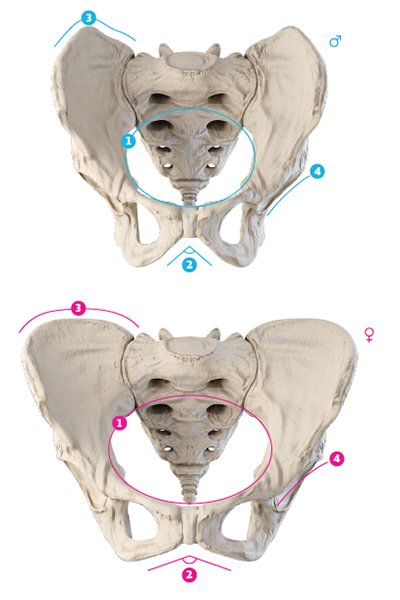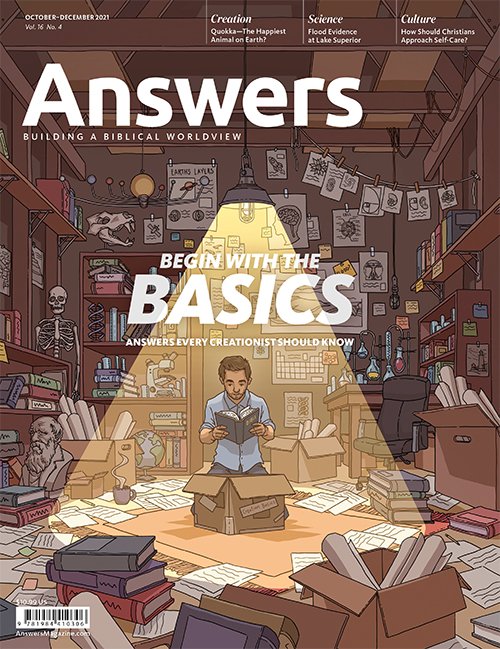The Gender of Bones
Skeletal Design
The Bible describes the creation of genders in Genesis 1:27: “So God created man in his own image, in the image of God he created him; male and female he created them.” Though our culture increasingly challenges the idea, scientists admit that biological gender is visible in basic human anatomy and in the genetic makeup of chromosomes. But the difference is also evident in an unexpected field: forensic anthropology.
Sometimes when a body is found, all that remains is the skeleton. Forensic anthropologists analyze bones to solve criminal cases and identify bodies. The structure of bones holds a wealth of information, such as health, age, height, and—most important to forensic analysis—gender. Bones aren’t colored pink and blue, and the differences between the structures can be subtle or more pronounced depending on the individual skeleton. However, when we look at the basic skeletal structure of males and females, we see differences that point to a wise Creator who designed the genders. We can praise our Creator, whose attention to detail goes all the way to the bone.
Planned-Out Pelvis

1. Pelvis Opening
Compared to adult males, the typical adult female pelvis has a rounder, flatter inlet from the top and a larger, rounder outlet below. Both features facilitate childbirth.
2. Pubic Arch
The pubic arch is the angle formed where the hip bones meet in the front. In males the pubic angle is sharper and more V-shaped. The wider pubic angle of the average adult female pelvis, closer to 90º, facilitates childbirth.
3. Illium
The fan-shaped ilium bone makes up the largest section of the hip bone. The ilium bears the upper body weight and supports the spine. The fan-shaped ilium is higher in males but wider in adult females, a wise design considering that females carry extra weight during pregnancy.
4. Acetabulum
The acetabulum is the cavity (socket) at the base of the hipbone where the ball of the femur fits. The male pelvis is narrower, placing the acetabula closer together and more directly above the lower limbs, causing the acetabula to face more laterally (toward the side). The wider female pelvis places the acetabula farther apart. Women’s acetabula are turned medially (toward the middle), causing a more hip-swinging gait.
One Fewer Rib?

Contrary to popular myth, males and females have the same number of ribs—two sets of 12. However, female ribs are generally 10% smaller in volume and inclined to allow for changes during pregnancy.
All In Your Head


1. Cranial Mass
The cranial mass of males is often greater than that of females due to the thicker, denser cranium bone. In males, the cranium is generally blocky and larger in size, while female skulls are rounder and more tapered.
2. Brow Ridge
The brow ridge is the bony crest on the skull’s frontal bone above the eye orbital. In males, this feature is prominent with thick, large features. A female’s brow ridge is thinner, softer, and more slender.
3. Cheek Bone
The zygomatic bone, located under the eye socket, is the widest part of the cheek. Males usually have a more prominent cheek bone. Females have a visually softer, less prominent zygomatic bone.
4. Eye Shape
Seven bones form the orbit which provides a protective barrier around the delicate eyeball. Male eye orbitals tend to be squarer and have blunt upper eye margins, while female orbitals are rounder with sharp edges in the upper eye margins.
Answers Magazine
October–December 2021
Curious about creation but don’t know where to start? Let’s begin with the basics.
Browse IssueRecommended Resources

Answers in Genesis is an apologetics ministry, dedicated to helping Christians defend their faith and proclaim the good news of Jesus Christ.
- Customer Service 800.778.3390
- Available Monday–Friday | 9 AM–5 PM ET
- © 2025 Answers in Genesis





